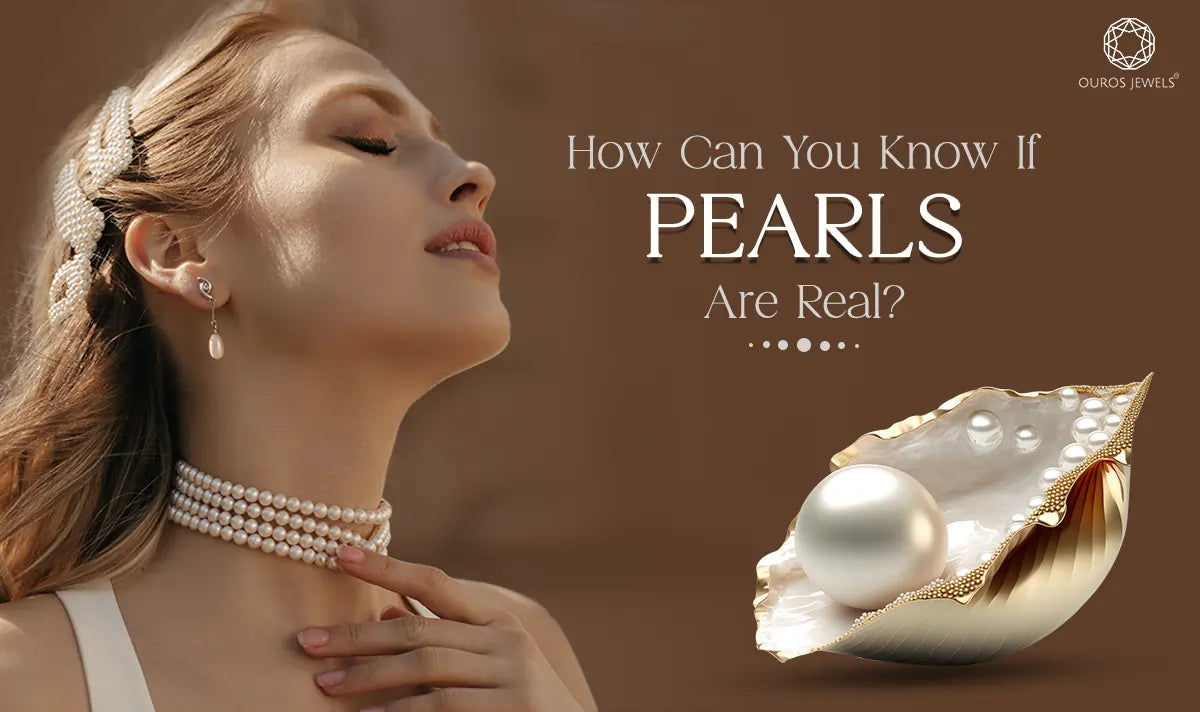

How to Identify Real Pearls: Simple Tests and Expert Tips

Real pearls are beautiful and valuable, but modern technologies make it more difficult to tell the difference between real and fake pearls. In the past, pearls were rare because they were only found in wild areas. Now, fake pearls made of glass or plastic can look very similar to real ones. This makes it easy to accidentally buy a fake. Knowing what real pearls look like and their unique qualities can be helpful if you want to be sure you're getting the real deal. In this guide, we'll provide you some simple guidelines for identifying real pearls so you can shop confidently.
What Are Real Pearls?
Real pearls are natural gems created by oysters in freshwater or saltwater. They can form naturally or with human assistance (cultured pearls). Cultured pearls are widely available and are considered authentic pearls, unlike fake pearls, which are often made of glass, plastic, or coated shells.
What Are Fake Pearls?
Fake pearls are man-made imitations designed to look like real pearls but lack the unique properties of natural or cultured pearls. They are typically made from materials like glass or plastic and can sometimes be challenging to distinguish from real pearls without close inspection.
8 Easy Ways to Tell If Pearls Are Real
Finding out if real or fake pearls is important when buying or checking your jewelry. Genuine pearls have natural features like slight imperfections, smooth hardness, and a soft glow. With a few easy at-home tests, you can easily check if your pearls are authentic without causing any damage.
- Check pearls for tiny irregularities
- Feel the pearls hardness
- Check the pearls Size
- Check the pigmentation
- Perform the tooth test
- Observe the pearls Color
- Do the rub test
- Pearls Fire test
![[How to Identify Real Pearls: Simple Tests and Expert Tips]-[ouros jewels]](https://cdn.shopify.com/s/files/1/0527/7669/8040/files/How_to_Tell_if_Pearls_are_Real_or_Fake_-_8_Steps_showing_how_to_identify_real_pearls_by_checking_for_imperfections_hardness_size_color_and_performing_tests_like_the_tooth_test_rub_tes_2048x2048.webp?v=1716876008)
-
Check Pearl For Tiny Irregularities
Examine each pearl for small flaws or differences in shape. Because pearls grow naturally, they typically have minor spots. If all the pearls look the same, they could be fake.
-
Feel The Pearl Hardness
Touch the pearls to see if they feel a bit rough. Because of the natural layers which make form real pearls, they are not perfectly smooth. Fake pearls frequently feel completely smooth, like glass or plastic.
-
Check The Pearl Size
Check the pearls to size if they are all the same size and shape. Natural pearls will show minor distinctions. Fake pearls are frequently identical because they are manufactured by machines.
-
Check The Pigmentation
Check how the pearls reflect light. Real pearls have a soft shine that changes depending on the light. Fake pearls usually just have a surface shine that doesn't change.
-
Observe The Pearls Color
Real pearls have a strong, natural color, a beautiful shine and limited color available. Like pink, white, cream, purple. If the pearls look too glossy or coated, they may be fake and all types of color available in fake pearls.
-
Perform The Tooth Test
Gently rub a pearl across your teeth. Real pearls feel a little gritty. Fake pearls feel silky and smooth.
-
Do The Rub Test
Rub two pearls gently together. Real pearls will feel a little gritty and may leave a thin powder. This doesn't happen with fake pearls, which feel smooth when brushed together.
-
Pearls Fire Test
Hold a pearl near a little flame (be careful). Real pearls are resistant to damage and have no smell. Fake pearls may smell like burnt plastic and melt or change color.
How Can I Find The Quality Of Real Pearls?
The quality of real pearls involves checking key features like shine, surface smoothness, shape, and size. Top-quality pearls have a bright glow, few imperfections, and a consistent round shape. Understanding these basics helps you pick genuine, high-quality pearls with confidence.
-
Pearls Shape
The shape greatly influences a pearl's quality. Freshwater pearls vary in shape, but perfectly round pearls are frequently the most valuable because of their rarity. Perfectly oval pearls may be more expensive than round pearls. Unique shapes like Baroque pearls, which are seed or tear-shaped, are extremely popular.
-
Pearls Size
Larger pearls are less common and more expensive. Pearl sizes are measured in millimetres and can range significantly.
-
Pearls Color
White and golden pearls are more valuable for their rarity. Pearls are also available in colors including lavender, pink, and rose, with costs changing according to color rarity.
-
Pearls Weight
Pearls are usually measured in carats, but for accuracy, the troy scale can be used. While fake pearls are typically far lighter, real pearls have a noticeable weight to them.
Why Buy from Trusted Retailers?
When you know how to buy real pearls, you should buy them from a trusted retailer. Making sure the store has been verified assures that the pearls are real and good quality. Buying from a reputable store means that you will receive excellent customer service, an acceptable refund policy, and the certainty that your pearls are value the cost. This makes sure your purchase is secure and satisfying.
-
Expertise
Experienced retailers understand pearls well. They can help you with the buying process and ensure that the pearls are ethically and of high quality.
-
Transparency
A good seller will explain what you're buying in simple terms. They will inform you about the type, origin, and other details of the pearl so you can make an informed choice.
-
Return Policies
Reputable sellers often have strong return policies. You need to be able to return the pearls without any problems if you're not satisfied with them or believe they might be fake.
-
Pearls Setting
If you buy loose pearls, an expert jeweler at a reputable store can make them into necklaces, bracelets, or earrings without affecting the pearls.
-
Reputation
Excellent pearls and customer service are likely to be located at a reputable store. Buying pearls from a reputable seller increases your chances that you can get real, quality pearls.
-
Quality Assurance
Trusted retailers often ensure the quality of their pearls. They offer proof or certifications proving the quality of the pearls. You can feel safe about your purchase as a result.
FAQs: How Can You Know If Pearls Are Real?
Q.1 How can I tell if pearls are real?
Ans. Real pearls are rarely perfect, so look for minor defects or slight differences in shape. Real pearls feel gritty, especially when rubbed between your teeth.
Q.2 What are the main differences between real and fake pearls?
Ans. Real pearls range in size and shape, with a deep shine that changes with light. They are larger than fake pearls, which typically look similar and feel smoother.
Q.3 Why should I buy pearls from a reputable retailer?
Ans. Buying from a reputable retailer promises that you receive real pearls. They provide quality assurance, good customer service, exact details on the pearls, and a best return policy.
Q.4 What simple tests can I use to check if pearls are real?
Ans. You may try a few easy tests at home:
- Tooth Test: Rub the pearl on your teeth. If it feels a little rough, it's probably real.
- Rub Test: Rub two pearls together. If they feel gritty and leave a fine powder, they are surely real.
- Fire Test: Carefully place a pearl near a flame. Real pearls do not crack or smell bad.
Q.5 How do reputable retailers check the quality of pearls?
Ans. Reputable retailers check pearls for shape, size, color, and weight. They have experts that can tell the difference between genuine and fake pearls as well as issue certificates of authenticity.
Q.6 What should I look for in the size and color of pearls when buying?
Ans. Choose pearls with natural variations in size and color. The color should have a deep, natural glow, unlike fake pearls, which can look too shiny or wildly colored.
Q.7 Can the way pearls are set indicate their authenticity?
Ans. Yes, the setting may suggest whether the pearls are real. Expert jewelers set pearls in a way that enhances their natural beauty without damaging them, such as drilling holes carefully for mounting.
Recent Blogs
-
July 19, 2025
-
June 19, 2025
-
May 6, 2025
-
April 22, 2025
-
November 28, 2024

 Solitaire Rings
Solitaire Rings

 Halo Rings
Halo Rings

 Bezel Rings
Bezel Rings

 Three Stone Rings
Three Stone Rings

 Five Stone Rings
Five Stone Rings

 Bridal Set Rings
Bridal Set Rings

 Solitaire Accent Rings
Solitaire Accent Rings

 Toi Moi Rings
Toi Moi Rings

 Semi Mount Rings
Semi Mount Rings

 Custom Rings
Custom Rings

 Color Diamond Rings
Color Diamond Rings

 Lab Gemstone Rings
Lab Gemstone Rings

 Men's Rings
Men's Rings

 Round
Round

 Pear
Pear

 Oval
Oval

 Princess
Princess

 Asscher
Asscher

 Marquise
Marquise

 Emerald
Emerald

 Cushion
Cushion

 Radiant
Radiant

 Heart
Heart

 Old Cuts
Old Cuts

 Eternity Bands
Eternity Bands

 Dainty Bands
Dainty Bands

 Custom Bands
Custom Bands

 Men’s Bands
Men’s Bands

 Studs
Studs

 Hoops
Hoops

 Jackets
Jackets

 Dangle
Dangle

 Bridal
Bridal

 Tennis Bracelet
Tennis Bracelet

 Fashion Bracelet
Fashion Bracelet

 Pendant
Pendant

 Necklace
Necklace

 Men's Jewelry
Men's Jewelry

 Pink
Pink

 Champagne
Champagne

 Yellow
Yellow

 Blue
Blue

 Black
Black

 Green
Green

 Olive
Olive

 Ruby
Ruby

 Sapphire
Sapphire

 Other Gemstone
Other Gemstone

 Old Cut Jewelry
Old Cut Jewelry

 Antique Diamond Jewelry
Antique Diamond Jewelry

 Kids Collection
Kids Collection

 Celebrity Jewelry
Celebrity Jewelry

 Old Cut
Old Cut

 Antique Cut
Antique Cut

 Matching Pair
Matching Pair

 Step Cut
Step Cut

 Rose Cut
Rose Cut

 Portuguese Cut
Portuguese Cut

 Portrait Cut
Portrait Cut

 Pie Cut
Pie Cut

 Champange
Champange

 Other
Other

 IGI-GIA Certified
IGI-GIA Certified

 8X Diamond
8X Diamond

 Ready Stocks
Ready Stocks

 OEC Round
OEC Round

 Old Mine Cushion
Old Mine Cushion

 Old Mine Moval
Old Mine Moval

 Old Mine Emerald
Old Mine Emerald

 Old Mine Asscher
Old Mine Asscher

 Old Mine Pear
Old Mine Pear

 Old Mine Heart
Old Mine Heart

 Rings
Rings

 Bands
Bands

 Earrings
Earrings

 Bracelets
Bracelets

 Anniversary Gift
Anniversary Gift

 Birthday Gift
Birthday Gift

 Gift For Her
Gift For Her

 Gift For Him
Gift For Him

 Under 300$
Under 300$

 Under 500$
Under 500$







